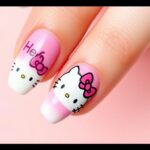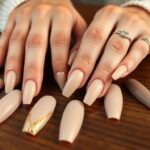Looking to elevate your manicure game without spending hours or very costly? We’ve got you covered with nail art designs that are both stunning and simple to create. These step-by-step tutorials will transform your nails from plain to fabulous in minutes.
We understand that intricate nail designs can seem intimidating, especially if you’re new to nail art. That’s why we’ve curated a collection of beginner-friendly techniques that require minimal tools and expertise. From playful polka dots to elegant marble effects, these easy nail art ideas will help you express your personal style with confidence.
10 Simple Nail Art Designs Anyone Can Master
- Polka Dot Perfection
Creating polka dots requires just two nail polish colors and a dotting tool (or bobby pin). Apply your base color and let it dry completely. Dip your dotting tool into the second color and gently press it onto your nail, creating evenly spaced dots. Repeat across all nails, then seal with a top coat for lasting results. This playful design works with any color combination and takes less than 10 minutes to complete.
- French Tip Twist
Modernize the classic French manicure by using colored tips instead of white. Start with a neutral base coat and allow it to dry. Place tape diagonally across your nail tips, creating unique angles. Apply your chosen color to the exposed tip, remove the tape while still wet, and finish with top coat. Your nails will showcase a contemporary geometric look that pairs perfectly with any outfit.
- Gradient Ombré Effect
Blending two complementary colors creates a stunning gradient effect. Paint your nail with the lighter shade and let it dry. Place a small amount of both colors side by side on a makeup sponge. Dab the sponge onto your nail, moving slightly up and down to blend the colors. Apply a clear top coat to smooth the texture and make your ombré pop.
- Simple Stripes
Striped designs offer endless possibilities with minimal effort. Apply your base color and wait until completely dry. Use striping tape or thin brush to create straight lines with a contrasting color. Try horizontal, vertical, or diagonal patterns for different looks. Finish with top coat to prevent chipping and enhance shine. This versatile design works for both casual and formal occasions.
- Minimalist Half-Moon
Half-moon manicures feature an elegant retro vibe that’s surprisingly easy to achieve. Apply a base coat in your preferred shade. Once dry, place round paper reinforcement stickers at the base of each nail. Paint the remaining nail with a contrasting color, remove the stickers before the polish dries, and add top coat. This sophisticated design takes just 15 minutes but looks professionally done.
- Dotted Floral Pattern
Create delicate flowers using just dots of polish. Start with a light-colored base. Use a dotting tool to make five dots in a circle with a contrasting color. Add a dot in the center with a third color to complete each flower. Space several flowers across your nails for a springtime garden effect. The entire process requires minimal artistic skill but delivers maximum impact.
- Negative Space Geometric
Negative space designs use your natural nail as part of the art. Apply small pieces of tape in geometric patterns on clean, bare nails. Paint over the entire nail with your chosen color. Carefully remove the tape while the polish is still slightly wet. Seal with top coat for a modern, minimalist look that’s both sophisticated and easy to create.
- Marble Effect
Creating marble nails is simpler than it looks. Paint nails with a white or light base color. Drop small amounts of 2-3 different polish colors onto a plastic surface. Swirl them slightly with a toothpick (don’t overmix). Dip a small makeup sponge into the mixed polish and dab onto nails. Clean excess polish from cuticles and apply top coat for a smooth marble finish.
- Glitter Gradient
Glitter gradients add instant glamour with minimal effort. Apply a solid base color and let dry. Apply glitter polish just at the tips, gradually working down toward the middle of the nail with decreasing pressure. Each stroke should deposit less glitter as you move down the nail. This creates a beautiful fade effect perfect for special occasions or adding sparkle to everyday looks.
- Tape Chevron
Chevron patterns create bold visual interest with clean lines. Apply base color and allow to dry completely. Place two pieces of tape in a V-shape on each nail. Paint over the exposed area with a contrasting color. Remove tape immediately while polish is wet. Seal with top coat for a crisp, geometric design that looks professionally crafted but takes under 20 minutes to complete.
Essential Tools for Easy DIY Nail Art

Creating beautiful nail art at home doesn’t require professional equipment or an expensive salon visit. With just a few essential tools, you’ll be able to design stunning manicures that look professional and express your personal style.
Basic Supplies You Already Have at Home
- Nail polish: Start with a variety of colors including base coats and top coats that will serve as your artistic palette for countless designs.
- Nail polish remover: This essential helps prepare your nail surface before application and allows you to quickly fix any mistakes during your nail art process.
- Cotton balls or swabs: These versatile tools are perfect for removing old polish, cleaning up edges, and creating precise details in your designs.
- Nail clippers and files: Properly shaped nails provide the ideal canvas for your artwork, so these basic tools are fundamental for any nail art session.
- Makeup sponges: Regular cosmetic sponges work wonderfully for creating textured effects, gradients, and ombre transitions between colors on your nails.
Affordable Tools Worth Investing In
- Detail brush: A fine-tipped nail art brush allows you to create intricate designs like delicate lines, hearts, and precise patterns that elevate your manicure.
- Dotting tool: Available in multiple sizes, these essential implements help create perfect dots for designs like cherries, flowers, or playful polka dot patterns.
- Nail tape: Thin adhesive strips make creating straight lines and geometric patterns effortless, particularly useful for designs like gold stripe nails and color blocking.
- Angled brush: This specialized tool helps create clean smile lines for perfect French manicures and can also assist with precise edge work.
- Nail guides or tip guides: These adhesive templates ensure crisp, clean lines and are particularly valuable for creating micro French tips or other precision designs.
- Glitter nail foils or charms: Add dimension and sparkle to your manicures with these decorative elements that create eye-catching holographic or grunge glam looks.
- Painter’s tape: This household item works brilliantly for creating sharp geometric patterns and can be cut to various shapes for creative design options.
Dotted Flower Nail Art: A Beginner’s Delight

Dotted flower nail art offers the perfect entry point for nail art novices looking to create elegant designs without complex techniques. This charming style combines simple dots with creative connections to form delicate floral patterns anyone can master.
How to Create Perfect Dots Every Time
Selecting the right dotting tool size is crucial for achieving consistent dots in your nail art. Dip your dotting tool into the polish and wipe any excess on the bottle’s rim to prevent overloading. Apply gentle, even pressure when pressing the tool onto your nail surface, releasing quickly to form uniform dots. Make sure your base color is completely dry before adding dots to prevent smudging or bleeding between colors. Space your dots evenly by mentally dividing your nail into sections before beginning. Work with small amounts of polish at a time, as thicker polish will create uneven dots that take longer to dry.
Transforming Dots into Delicate Flowers
Creating floral designs starts with placing five dots in a circular pattern on your nail. Use a small detail brush to connect these dots with gentle strokes, forming the outline of flower petals. Add a contrasting center dot to complete each flower and enhance the design’s dimensionality. Vary the size of your flowers by using different dotting tool tips for a more natural, garden-inspired look. Position multiple flowers across your nails at different angles for an organic, scattered effect. Finish your dotted flower nail art with a clear top coat to seal the design and add a glossy finish that enhances the colors. Allow sufficient drying time between adding elements to prevent smudging your delicate flower patterns.
Marble Effect Nails Without the Mess

Creating gorgeous marble nails doesn’t have to be complicated or messy. We’ve perfected two simple techniques that deliver stunning marble effects with minimal cleanup and maximum impact.
Dry Marble Technique Using a Toothpick
The dry marble technique offers a mess-free alternative to traditional water marbling. Start by applying a base coat and allowing it to dry completely. Next, add a layer of clear polish or a special marbling medium to create a wet surface for your design. Place small dots of different colored polishes directly onto the nail, positioning them close enough to blend. Grab a toothpick and gently swirl the colors together, dragging it in various patterns to create unique marble veining. Try circular motions for classic marble or straight lines for a more modern look. Finish with a quality top coat to seal your design and add shine. This method works beautifully with contrasting colors like white and black or complementary shades for a more subtle effect.
Water Marbling the Simple Way
Traditional water marbling gets a simplified makeover with this beginner-friendly approach. Fill a small cup with room temperature water and add a few drops of your chosen nail polish. Watch as the polish spreads across the water’s surface, creating a thin film. Use a toothpick to create patterns on the water surface—try spirals, zigzags, or concentric circles for different effects. Dip your finger straight down into the water, ensuring your nail fully submerges in the polish design. Apply tape around your cuticles beforehand to make cleanup easier. Remove excess polish from around the nail bed using a cotton swab dipped in remover. Apply a clear top coat to protect your unique marble design and enhance its longevity. This technique delivers professional-looking results without specialized tools or advanced skills.
Striping Tape Magic for Clean Lines

Striping tape is a game-changer for achieving professional-looking nail art with precise, clean lines. This versatile tool allows even beginners to create stunning designs that look salon-quality with minimal effort.
Gold Stripe Nail Tutorial
Creating perfect gold stripes on your nails is surprisingly simple with the right technique. First, apply a base coat and let it dry completely to ensure the tape adheres properly. Next, position thin strips of nail tape across your nails in your desired pattern—straight lines, diagonals, or criss-cross designs all work beautifully. Carefully paint over the exposed nail areas with gold polish, making sure not to oversaturate the brush. Wait until the polish is nearly dry but still slightly tacky before gently removing the tape at a 45-degree angle. This timing is crucial for achieving those crisp, sharp lines that make your design look professional. Finish with a glossy top coat to seal and protect your artwork.
Multi-Color Stripes
Multi-color striped designs add vibrant dimension to your manicure with minimal effort. Begin with a fully dried base color of your choice. Apply several strips of striping tape parallel to each other, ensuring they’re firmly pressed down to prevent polish bleeding. Using different polish colors, paint between the tape strips, creating alternating bands of color. For best results, work with one color at a time and allow brief drying time between shades. Remove the tape while the polish is still slightly wet for the cleanest lines. This technique works wonderfully with complementary colors for a harmonious look or with contrasting shades for bold, eye-catching nails.
Creating Geometric Patterns with Tape
Geometric nail designs instantly elevate your manicure with their modern, structured appearance. Start with a fully dried base coat before positioning your striping tape to create shapes such as triangles, diamonds, or abstract patterns. The key to successful geometric designs lies in planning your pattern before applying the tape—consider sketching your idea on paper first. Apply your chosen polish colors carefully within the taped sections, working with one area at a time. For multi-colored geometric designs, let each section dry before taping off adjacent areas. Remove the tape while the polish is still slightly wet by pulling it straight up to avoid smudging. This technique creates precise edges that define your geometric shapes perfectly.
Chevron Nails
Chevron patterns add ever-changing visual interest to your nails with their distinctive zigzag appearance. Apply a solid base color and allow it to dry completely. Position striping tape in V-shapes across your nails, pressing firmly along the edges to prevent bleeding. Paint over the exposed areas with a contrasting color—metallic shades work particularly well against matte bases for added dimension. Carefully remove the tape while the polish is still slightly tacky, pulling straight up to avoid disturbing the clean lines. The resulting chevron pattern creates an optical illusion that makes your nails appear longer and more elegant. Finish with a high-gloss top coat to enhance the contrast between colors.
Negative Space Designs for Modern Look
Negative space nail art incorporates the natural nail (or base color) into the design for a contemporary, minimalist aesthetic. Begin by applying a clear base coat for protection. Place nail guides or striping tape to create boundaries for your negative space areas—these will remain untouched while you apply color to the rest of the nail. Popular negative space designs include geometric shapes, asymmetrical sections, or outlined patterns. Apply your chosen polish to the exposed areas, taking care not to flood the tape edges. Remove the guides while the polish is still slightly wet for the crispest lines. This technique works particularly well with bold, highly pigmented colors against the natural nail for maximum contrast.
Half-Moon Nails
Half-moon manicures offer a sophisticated twist on the negative space trend with their vintage-inspired elegance. Start with a clear base coat on clean, shaped nails. Place circular stickers or specialized nail guides at the base of each nail, covering the crescent-shaped area where your natural nail moon appears. Apply your chosen polish color to the rest of the nail, making sure to create a clean line against the sticker edge. For a modern interpretation, try using metallic polish against a nude base or vibrant colors for a bolder statement. Remove the sticker or guide while the polish remains slightly tacky to reveal a perfect half-moon negative space. This design elongates shorter nails and provides a refined finish that works for any occasion.
Gradient Nails: Effortless Ombre Effect

Creating stunning gradient nails at home is easier than you might think. With just a few supplies and some simple techniques, you can achieve salon-worthy ombre effects that blend colors beautifully.
Sponge Technique for Smooth Color Transitions
The sponge technique is our favorite method for creating flawless gradient nails. Start by applying a clear base coat to protect your natural nails. Next, select two to three complementary polish shades that transition smoothly from one to the next. Cut a makeup sponge into a smaller piece or use a specialized nail sponge for better control. Paint your chosen nail polish colors directly onto the sponge in horizontal stripes, slightly overlapping each color to create a gradient pattern. Gently dab the sponge onto your nail, ensuring even coverage while moving from the cuticle toward the tip. This dabbing motion creates that smooth, professional-looking transition between colors. Clean up any excess polish around your cuticles and nail bed using a cotton swab dipped in nail polish remover. Finish by sealing your design with a clear top coat to prevent chipping and add shine.
Two-Tone Gradients for Everyday Wear
For a simpler approach that’s perfect for everyday wear, try creating two-tone gradients. Apply a base coat followed by your first color across the entire nail. Once dry, use nail guides or tape to section off the tip of your nail. Apply the second color to the exposed tip area, creating a clean line where the colors meet. Carefully remove the tape or guides while the polish is still slightly wet to reveal a crisp, two-tone gradient effect. For a more seamless transition, you can use a small brush to gently blend the two colors where they meet. This technique works beautifully with neutral tones for office settings or bold color combinations for special occasions. Seal your design with a top coat to enhance durability and give your nails that professional glossy finish. We’ve found this method particularly time-efficient when you need an eye-catching manicure without spending hours on intricate details.
French Manicure with a Twist

The classic French manicure gets a modern update with these creative variations anyone can achieve at home. We’ve collected some of the simplest yet most striking ways to reinvent this timeless style.
Heart French Manicure
Transform your traditional French tips into lovely heart designs with minimal effort. Start by applying a pink polish to create your French tip base. Once dry, use a small dotting tool to place two pink dots side by side near the tip edge. Complete the heart by drawing a “V” shape line connecting the dots downward. This adorable design allows you to customize with multiple hearts per nail for a playful look that’s perfect for Valentine’s Day or anytime you want to add a touch of romance.
Micro French Tips
The micro French tip offers a subtle, contemporary take on the traditional style. Rather than the classic long white tip, apply a thin, short line of color at the very edge of your nail. Achieve perfect precision by using nail guides or stickers as barriers. This minimalist approach works beautifully with traditional white polish but can be modernized with any color for a fresh, fashion-forward look that’s suitable for both professional settings and casual wear.
Updated French Tips Using Household Items
Using Nail Tape
Nail tape creates flawlessly straight edges for your French tips without professional tools. Apply the tape across your nail, leaving just the tip exposed for painting. Press down firmly to prevent polish from bleeding underneath the edge. Paint your chosen color on the exposed tip, then carefully remove the tape while the polish is still slightly wet for the crispest line. This technique ensures salon-quality results even for beginners.
Painter’s Tape
Painter’s tape serves as an excellent alternative for creating geometric French tips at home. Cut small strips of tape and position them diagonally, horizontally, or in creative patterns before applying polish. The tape’s low adhesive quality prevents damage to your base coat while still creating clean lines. Try creating chevron patterns, diagonal French tips, or color-blocked designs with this versatile household item for unique manicures that look professionally done.
Colorful French Designs for Every Season
Spring French Manicure
Welcome spring with pastel-colored French tips that capture the season’s fresh energy. Apply soft mint, lavender, or baby blue polish to your tips instead of traditional white. Add delicate details using a dotting tool to create small flowers or dots along the tip line. Pastel yellow and pink combinations work particularly well for spring celebrations, providing a cheerful yet sophisticated look that transitions beautifully from office to weekend wear.
Cherry French Manicure
Create a playful summer look with cherry-themed French tips that add a pop of color. Apply traditional French tips as your base, then use a dotting tool and cherry red polish to create small circles for cherries near the cuticle or along the sides. Add tiny green stems with a detail brush for the complete fruit effect. This fruity variation brings a fun, seasonal element to the classic design and pairs beautifully with both neutral and bold base colors.
Ombre Heart French Manicure
Combine two popular techniques with an ombre heart French design. Create a color gradient by applying polish at the tip and using a small, firm brush to blend it toward the middle of your nail. While the polish remains tacky, use a thin brush to draw heart outlines along the ombre line. The gradual color transition adds dimension to your manicure, while the heart details incorporate a sweet, romantic element perfect for date nights or special occasions.
Gold Stripe French Manicure
Elevate your French manicure with luxurious gold accents for an eye-catching effect. Apply your preferred French tip color, then use gold nail tape or a thin brush with gold polish to create stripes across the tips or along the smile line. The metallic element adds sophistication to the traditional design, making it suitable for evening events and celebrations. Gold pairs especially well with nude, pink, or even black base colors for a striking contrast that catches the light beautifully.
Easy Stamping Techniques for Intricate Designs

Nail stamping offers a fantastic way to create detailed designs without advanced artistic skills. Follow these simple steps to achieve salon-quality nail art at home.
- Preparation
Start by applying a base coat to protect your nails and ensure better polish adhesion. Add a thin layer of your chosen base color and allow it to dry completely before beginning the stamping process.
- Choosing the Right Tools
Invest in a quality nail stamping kit that includes stampers, plates with various patterns, and a scraper. Selecting the right plate design is crucial for achieving your desired look.
- Applying the Polish
Place a small amount of stamping polish onto your chosen design on the plate. Use the scraper at a 45-degree angle to remove excess polish, ensuring only the engraved design remains filled.
- Stamping the Design
Press your stamper gently but firmly onto the filled design to pick up the polish. Roll the stamper carefully over your nail to transfer the pattern. Repeat this technique for each nail, adjusting placement as needed for a cohesive look.
Beginner-Friendly Stamping Tips
- Practice Makes Perfect
Begin with simple designs and practice on nail wheels or fake nails before attempting on your actual nails. This approach allows you to perfect your technique without the pressure of immediate results.
- Use the Right Polish
Choose polishes specifically formulated for stamping, as they contain a thicker formula that transfers more effectively. Regular polish often dries too quickly or lacks the opacity needed for clear stamping results.
- Clean Up Efficiently
Keep lint-free wipes or cotton swabs dipped in nail polish remover handy to clean up any mistakes. Quick cleanup around your cuticles and nail bed will give your finished design a professional appearance.
Creating Custom Patterns with Stamps
- Layering Designs
Create depth and complexity by layering different stamping patterns over each other. Apply a base design first, let it dry for 1-2 minutes, then stamp additional patterns in contrasting colors for truly unique nail art.
- Combining Stamping with Other Techniques
Enhance stamped designs by incorporating complementary nail art methods such as dotting tools or freehand details. Add accent dots, lines, or embellishments to your stamped pattern for dimension and personalization.
- Experimenting with Colors and Plates
Try unexpected color combinations and mix different stamping plates to create original patterns. Metallic and holographic polishes work particularly well for stamping, adding dramatic visual interest to even the simplest designs.
Quick Dry Techniques for Busy Schedules

For nail art enthusiasts with packed schedules, mastering quick-dry techniques is essential to achieve beautiful manicures without the long wait times. We’ve compiled the most effective methods to speed up your nail polish drying time while maintaining quality results.
Fast-Drying Top Coats
Fast-drying top coats serve as your first line of defense against long waiting times. These specialized formulas seal in your nail polish and significantly accelerate the drying process. A single layer can transform your drying time from an hour to just minutes.
Professional nail artists recommend applying thin, even coats to maximize effectiveness. Many fast-drying top coats also provide additional benefits such as chip resistance and a glossy finish, making them a multifunctional addition to your nail care routine.
Nail Dryers and Cooling Methods
Investing in a nail dryer can revolutionize your manicure routine. UV/LED lamps cure polish in minutes rather than the extended time required for air drying. These devices work particularly well with gel polishes and specialized formulas.
Cool air techniques offer another effective drying solution. Setting your hair dryer to the cool setting and directing it at your freshly painted nails helps harden the polish quickly. This method works by accelerating the evaporation process without the heat that can cause bubbling in your polish.
Quick-Dry Drops
Quick-dry drops represent one of the most convenient innovations in nail care. Applied after your top coat, these specialized oils penetrate through layers of polish to speed up evaporation from the inside out.
Most drops contain ingredients that both accelerate drying and condition cuticles simultaneously. Users typically see results within 60 seconds of application, making these drops perfect for last-minute touch-ups before heading out the door.
Preventing Smudges and Dents
Base and top coats create essential protective layers that minimize the risk of smudges and dents. Starting with a quality base coat provides a smooth foundation while improving polish adhesion. Top coats add a protective shield that helps your manicure withstand daily activities.
Keeping hands still during drying time prevents unfortunate mishaps. Avoid touching or handling objects until your nails are completely dry, particularly in the first 10-15 minutes after application when polish remains most vulnerable to damage.
Thin polish layers dry much faster than thick ones. Apply multiple thin coats rather than one thick layer to reduce drying time and prevent bubbling or wrinkling. Each layer should appear almost transparent before adding another coat.
Products That Speed Up Drying Time
Fast-drying nail polishes contain modified formulas that cut waiting time dramatically. Brands specifically label these products as “quick-dry” or “fast-dry,” and they typically contain solvents that evaporate more rapidly than traditional polishes. These specialized formulas allow busy individuals to complete a manicure in half the usual time.
Nail polish dryers like Sally Hansen Insta-Dri and ORLY Sec ‘N Dry have gained popularity for their remarkable effectiveness. These products activate chemical reactions that speed up the hardening process of nail enamel. A few drops applied to freshly painted nails can reduce drying time by up to 60%.
UV/LED lamps provide the fastest drying solution for compatible polishes. These devices emit exact wavelengths that cure certain polish formulations in as little as 30-60 seconds per coat. While traditionally used for gel manicures, many regular polishes now respond to these lamps, making them versatile tools for any nail enthusiast with time constraints.
Nail Art Hacks Using Everyday Items

Looking to create stunning nail art without investing in expensive tools? Your household items can double as perfect nail art tools with these creative hacks.
Kitchen Tools for Unique Patterns
Kitchen tools offer surprising versatility for nail art designs. Toothpicks make excellent substitutes for professional dotting tools, allowing you to create precise dots for cherry designs by placing two dots side by side. Bobby pins can also function as dotting tools—simply dip the rounded end into polish and press gently onto your nail. Regular Scotch tape works wonderfully for creating clean, straight lines and geometric patterns, similar to how painter’s tape ensures crisp edges. Try arranging pieces of tape in different configurations on your nails before applying a contrasting polish color, then remove the tape while the polish is still slightly wet for sharp, defined lines.
Makeup Sponges, Straws, and Bobby Pins as Nail Art Tools
Makeup sponges transform ordinary manicures into professional-looking gradient designs. Cut a small piece from a makeup sponge, paint horizontal stripes of different polish colors directly onto the sponge, then dab it onto your nail for a perfect ombre effect. Straws offer a clever solution for creating unique marbled patterns—drop different colored polishes onto water, use a straw to gently blow across the surface, and dip your nail in to transfer the swirly design. Bobby pins serve multiple purposes in nail art—bend them into different shapes to create various stamping tools, use them straight for striped patterns, or form them into hearts for Valentine’s designs. Household items can also enhance your nail art with decorative elements; try applying nail charms or stickers like stars and hearts with a small drop of nail glue for added dimension to your manicure.
How to Make Your DIY Nail Art Last Longer
We’ve explored many nail art techniques that anyone can master at home with minimal tools and experience. By trying these simple designs you’ll discover just how creative you can get with your manicures.
Remember that practice makes perfect and don’t be afraid to experiment with different color combinations and patterns. The joy of DIY nail art is that it’s completely customizable to your personal style and mood.
With the techniques we’ve shared you can transform your nails from basic to breathtaking without spending hours or very costly. So gather your supplies pick your favorite design and let your creativity shine through your fingertips!
Frequently Asked Questions
What tools do I need to start creating nail art at home?
You only need basic supplies like nail polish, remover, cotton balls, clippers, and files to begin. For more advanced designs, consider investing in affordable tools like detail brushes, dotting tools, nail tape, angled brushes, nail guides, glitter foils, and painter’s tape. The good news is that you don’t need professional equipment to create beautiful nail art at home.
How can I create marble effect nails without making a mess?
Try the Dry Marble Technique by swirling different colored polishes on a wet surface using a toothpick, or the Water Marbling method using room temperature water to create patterns. Both techniques are simplified versions of professional methods and require minimal cleanup. Always finish with a clear top coat to protect and enhance your marble design.
What’s the easiest nail art design for beginners?
Dotted Flower Nail Art is perfect for beginners. Create five dots in a circular pattern using a dotting tool, connect them with a detail brush to form petals, and add a contrasting center dot. Polka Dot Perfection is another beginner-friendly option requiring just two colors and a dotting tool. Both designs can be mastered within minutes.
How do I create a gradient or ombré effect on my nails?
Use the sponge technique for smooth color transitions. Apply two to three complementary polish shades side by side on a makeup sponge, then dab onto your nails for a blended effect. For a simpler approach, try a two-tone gradient by sponging one color at the base of your nail and another at the tip. Seal with a top coat for durability.
Can I create nail art with household items?
Absolutely! Use toothpicks or bobby pins for dots and patterns, Scotch tape for clean lines and geometric designs, makeup sponges for gradients, and straws for unique marbled patterns. These common kitchen tools can serve as effective nail art tools, making the process more accessible and affordable.
How do I make my nail polish dry faster?
Use fast-drying top coats, nail dryers, or cooling methods like cold water dips. Quick-dry drops can enhance drying efficiency when applied over wet polish. Apply thin layers of polish to reduce drying time, and consider investing in fast-drying nail polishes or UV/LED lamps if you’re frequently on a tight schedule.
What are some modern takes on the classic French manicure?
Try the Heart French Manicure featuring heart designs, Micro French Tips for a subtle look, or the Gold Stripe French Manicure for a luxurious touch. Seasonal variations include the Spring French Manicure and Cherry French Manicure. The Ombre Heart French Manicure combines gradient and heart elements for a unique style.
How do I use nail stamps for intricate designs?
Start by preparing your nails with base coat and color. Apply stamping polish to your chosen design plate, scrape excess, and pick up the design with a stamper. Roll the stamper onto your nail and seal with top coat. Practice is key for perfect results. Layer designs or combine with other techniques for unique looks.
How can I create clean lines in my nail art?
Use striping tape or painter’s tape for precision. For chevron patterns, place tape diagonally across nails before applying polish. For geometric designs, arrange tape in desired patterns and paint over it. Remove tape while polish is still wet for the cleanest lines. Seal your design with a top coat for longevity.
How long does it take to create simple nail art designs?
Most of the designs featured in the article can be completed in under 20 minutes, making them perfect for busy schedules. Simpler designs like polka dots or stripes may take just 5-10 minutes, while slightly more complex designs like marble effects might take 15-20 minutes. Practice will help you become faster over time.







